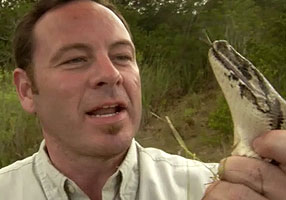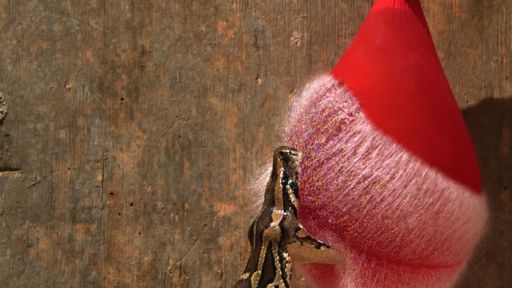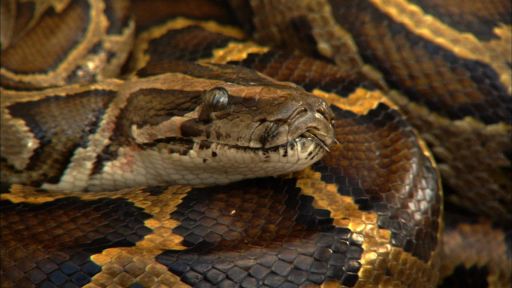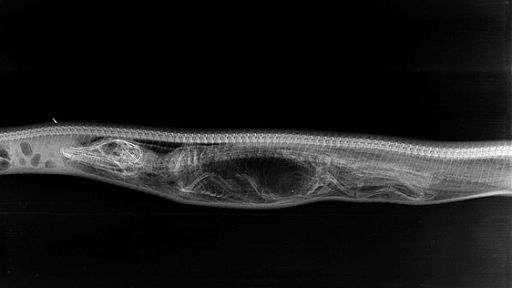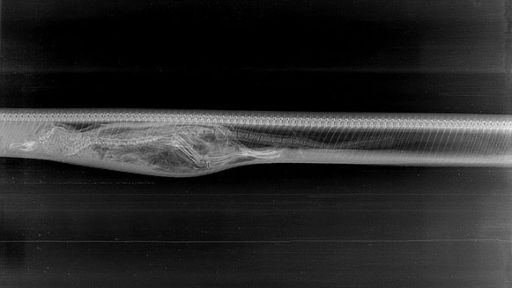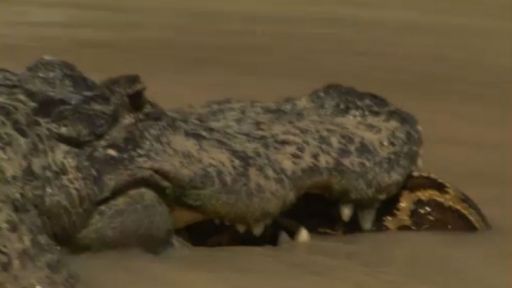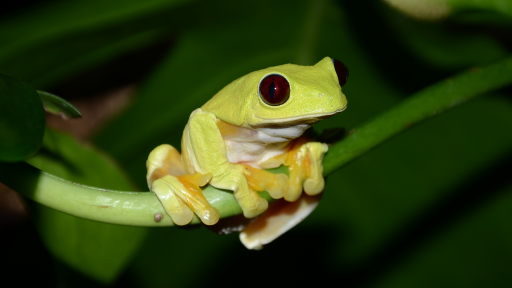Herpetologist Shawn Heflick, featured in Invasion of the Giant Pythons, is President of the Central Florida Herpetological Society. He has a permit to hunt down Burmese pythons in the Everglades, and he’ll be out in the field doing just that the weekend our program premieres.
Submit your questions for Shawn Heflick in the comments field below, and he’ll respond to them during the week of February 22.
—
Dr. Wyman asks:
What is your opinion of the USGS report and its prediction of the spread of these animals?
Shawn says:
Scientifically, I think the USGS report should have undergone a more stringent peer review process before being released. Issues with the use of data from the Indian python instead of the Burmese python, and speculative global climate change models would surely have raised red flags with colleagues in the peer review process. The recent cold snap in south Florida is also yielding interesting data, which includes many deaths within this wild Burmese population that would seem to refute the USGS report.
—
Teresa asks:
I’ve heard that it’s possible that there are tens of thousands of pythons in the Everglades. Do you think that this number is accurate? Is it an exaggeration, or are there really that many pythons in the Everglades?
Shawn says:
From being on the ground and in the field with these animals, myself and others believe that the true number is closer to between 5,000 to 10,000 animals. The 100,000 plus numbers are inflated and sensationalized by politicians and some of the local media, but no one has the real answer to exactly how many are out there.
—
Rebecca asks:
Is there any genetic evidence that the pythons in the Everglades are from diverse stock, as would be expected if the pythons are largely released/escaped pets? I’ve heard some say that many of the pythons are escaped from a military operation and that they are closely related genetically. Can you “shed” any light on this topic? Thanks.
Shawn says:
Hey Rebecca. There is very little genetic variation within this wild population. The genetic study done on this population suggests that the population stems from the Hurricane Andrew devastation in 1992. At least one facility had over 900 Burmese pythons at the time and was destroyed completely. This facility was within just a mile or so of what is believed to be the epicenter of the population, and it possessed animals from the same genetic origin. Since 1992 the FWC has put into place more stringent regulations on housing, disaster protocols and bio security in general.
—
Nancy asks:
Please tell me these snakes froze this winter!!!
Shawn says:
We are seeing a number of dead and dying pythons from the freeze. The data is still being collected, but it does appear that a large number have succumbed to the prolonged and severe cold. I think we will see a decreased breeding event for 2010 from this severe winter.
—
Douglas Bellizzi asks:
It’s not just the ecosystem. What about the danger to the human population? These animals are dangerous and they are stealthy. When it comes to the safety of human beings, there can be no apologia whatever for these animals.
Shawn says:
Hey Douglas. The human safety factor is NOT an issue with this wild population. Not one human has been attacked or injured from one of these wild pythons and they are not prone to attack humans unless molested or grabbed. You are much more likely to be bitten by your own pet dog, get into a car accident or struck by lightning.
—
Suzanne asks:
Would these snakes ever attack a person in the open? Do these snakes enter residential areas in search of food or warmth? And is there something they don’t like or stay away from that someone could carry, in case of a run-in with a python?
Shawn says:
Hey Suzanne. These wild pythons have not attacked humans and are NOT a public safety issue. They may venture into rural or suburban areas, but are quickly spotted, run over on roads or captured. The best thing to carry is common sense… stay away from one if you see it and call FWC or your local police department.
—
Nathan B asks:
What, in your opinion, is the most effective solution to address this South Florida issue? There have been a number of solutions posed that failed to take into account the limited scale of the issue and attempted instead to make it a national issue. HR669, S373, and the Injurious Species Provisions of the Lacey Act penalize responsible owners and breeders of constrictor snakes across the other 49 states where the potential for survivability of these snakes in the wild is absolutely nil. Eliminating these animals from the pet trade does not address the established population in the far south of Florida and only harms the responsible keepers and small businesses that make up the captive-bred reptile industry.
Shawn says:
Good questions, Nathan. FWC has already implemented serious regulations over the last several years which have worked! The numbers of large pythons in the pet trade is now almost non-existent and the vast majority of people who still own them are permitted, responsible, educated people who are helping FWC with the problems through their 24/7 Amnesty Program. A BAN is NOT the answer. Historically bans do not work. They simply force things underground. Many of my biologist peers with whom I have spoken agree that a ban will cause massive problems for the state of Florida and the U.S. It will create a black market, force real releases of “now worthless or illegal” animals and create an atmosphere of distrust with the government. Regulations are the way to proceed, because they still give wildlife agencies the ability to keep tabs and regulate the animals.
—
Tony F. asks:
Why must the pythons be destroyed? Why not capture and relocate them to their natural habitat like some other wildlife programs out there? It’s understandable people may not want them there, especially if they are not native to the land, but must they really be destroyed? I personally love pythons. I prefer ball pythons since they stay relatively small though. I had a Burmese before but it died due to illness. I would just hope people could find a better solution rather than eradication. Education would be a start. If the cause of them being there is due to people “dumping them off” when they are no longer wanted or get too big, the problem will never be fixed until people learn not to dump them there in the first place. Owning a Burmese or any other large snake is just like owning any other pet. Do your research and use some common sense before purchasing one.
Shawn says:
I truly enjoy these animals as well, Tony, but you cannot relocate animals back into Southeast Asia due to disease concerns and the massive monetary costs involved. And you are right about people educating themselves before they make a purchase… no matter whether it is a dog, cat, fish, bird or reptile!
—
Matt asks:
Don’t all tropical wetlands except the Everglades have large constrictors and crocodilians present? What extended effect would large constrictors have on the Everglades in the long run, considering the skin trade and tourist dollars? What effect did the hard freeze have on the Asian and South American feral animals in South Florida, considering the damaging effect it had on native reptiles? Are there any plans in place for dealing with iguanas, Cuban anoles, or kudzu? Does anyone actually think that pythons could survive more that a year anywhere else in North America? Do normal people ever do the math on how many kids die from drowning or infanticide compared to the numbers that die from constrictors worldwide? Aren’t mustangs an invasive species? What’s your professional opinion on the considered “Python Ban” when they haven’t fully enforced the recently enacted R.O.C. laws in Florida? What in the world does the U.S.G.S. know about reptiles, outside of Disney cartoons? Is everyone’s normal reaction to new events to ignore it for a while, then dramatically over react?
Shawn says:
All good questions, Matt. Yes, many of the tropical wetlands have native species of crocodilians and boids, but the Everglades did not… until now. We do not know what long term effects the pythons might have on the Everglades, but they do have the potential to do damage to the indigenous wildlife and thus a proactive approach is best. The recent freeze has caused problems with many exotics (and native species) and numbers of iguanas, pythons, fish, frogs and plants were knocked back by the cold temperatures, but not eradicated. A ban is NOT the answer, but instead the new FWC regulations need to be given more time to work. They already have stopped most of the pet trade in large constrictors in the state.
—
Victor W. asks:
I am a member of the Kansas Herpetology Society. I am a teacher here in Kansas so I am off in the summer. If you were to have a need for summer python help, my wife may let me come down for a month. All I need is a cheap place to crash.
Shawn says:
Hey Victor. Kudos on being a member of the KHS. Herpetological Societies are a huge educational resource and a great way to get educated about reptiles and amphibians! I’m sure we could find some fellow herpers to aid you in your aspirations for herping Florida.
—
Jon asks:
Unanswered questions that come to mind: 1. How long do the pythons live? 2. How big do they grow? I heard 15′, 20′, 25′ during the course of the show. Do females grow bigger than males? 3. How far north are they likely to spread? Do they hibernate? 4. Why do some Burmese pythons have pale markings, and others a deep pattern? 5. Are they the top predator in their original Burmese habitat? What do they co-exist with there? How do people deal with them? 6. Could the meat and skin become a new Florida export? 7. What other extermination methods are under consideration besides hunting individual snakes? 8. The program mentioned reticulated pythons, but focused on Burmese. What is the difference? Are the reticulated also invading South Florida?
Shawn says:
They can live over 25 years in captivity… in the wild it is unknown. Males may reach 14 feet while females can get over 20 feet. It is unlikely that they will move any further north than they already have due to cold temperature restrictions. They do not hibernate, as they evolved in a tropical system in Southeast Asia. Like most species, there is variability in their color and patterns. Many dark animals you see may also be in late stages of ecdysis (shedding their skin). They are a top predator in their native systems, but have predators as well. Southeast Asia has crocodiles, large cats, birds of prey and many more. Remember that most of the hatchlings are eaten before ever making it to adulthood, so many animals prey upon them. Contrary to popular belief, they are not a threat to people in their native range or in the U.S. The skin could potentially be of value, but there are reports that the meat has high levels of mercury in it. Pheromone baiting, long net trapping, infrared aerial tracking are a few other management strategies that have been considered. The reticulated python is a different species of large constrictor from Asia as well, but it is not invading South Florida.
—
El Sanburg asks:
What are the actual population – and range – estimates based upon for the feral pythons and lizards: hype, fear, politics, or true science? We really need to know the results of factual scientific data and not, as several animal-control people presented, ‘guesstimates’ or beliefs based on unsystematic and biased collection samples. I would very much appreciate a lead on the published references for these data. With respect to the Florida pythons’ stomach contents that were reported in this program: what are the complete species lists and individual counts in the stomach contents for each and all of the snakes; how many snakes were sacrificed for the study population; what size, age estimates, and sex were these snakes; how many were gravid; where were their capture locations; in what year, season and weather was each snake captured; how many snakes were thriving, versus starving or ill; and why are we ONLY presented, in this program, with the endangered species that were eaten and not the full range of presumably more-available non-endangered animals?
Shawn says:
All good questions El. Much of what you ask has not been tabulated between the different agencies that are involved in this program… Department of Interior, South Florida Water Management and the FWC. Much of this data is also being written into scientific papers right now and thus are not currently in published references as yet. As far as the actual population numbers… there is no way to know that. True numbers for any species on this planet are not known unless they are so endangered that there are only a handful left. Population numbers are built on field counts and extrapolated or plugged into models. Clearly we cannot count every snake. Distribution is a little easier, but still not 100% accurate. This population appears to be centered in South Florida outside of Florida City and Homestead and into the Everglades National Park. Yes, the majority of the prey items of the pythons are NOT endangered and include rodents, lagomorphs, birds, a deer, a bobcat and a handful of small alligators.
—
Reji asks:
How do I discuss this topic with folks I care about that are working in that area?
Shawn says:
Ask lots of questions! Gather as much info as possible so you are informed. Remember that even the “experts” don’t have all the answers. We are still trying to figure it out!
—
Isaac Pitts asks:
a.) What would I need to get a permit to hunt pythons in Florida? b.) Who hires the hunters, and do they plan on hiring more people to hunt pythons in Florida? c.) What does this job pay \ is it a hobby? d.) Are you allowed to hunt in the Everglades National Park, or do you have to find them outside of the park? e.) Is there a current market for the skin\meat of the python’s that are hunted? f.) Do you work with people that euthanize or is that a separate group of people hired by the Florida government \ park service?
Shawn says:
Go to www.myfwc.com for permit requirements and more info about the program. The hunters are not hired… we are all volunteers, and there is no pay. The permits for the state (FWC) and the Everglades National Park are two different permits/programs. There is not currently a market for python skin, but it is being looked at. The meat has high levels of mercury in it and thus is not good for human consumption. Some animals are euthanized, some are taken for further studies and research.
—
Melissa Kendall asks:
A recent article stated that Fish and Game estimates that 50% of non native green iguanas were killed in the latest cold snap in the Glades. How many large snakes do you think were killed? What temperatures are usually necessary to dispatch a large snake like a Burmese?
Shawn says:
Hey Melissa. I think the 50% may be a low figure for iguana mortality. There is no real way to know how many Burmese pythons died from the cold, but we are finding approximately the same amount dead as alive. Prolonged temperatures in the 30s and 40s (Fahrenheit) can be deadly for these tropical animals. Freezes are killers for this species.
—
Julie asks:
As a former employee of Flamingo, I saw pythons kept as pets. I lived there in the late 80s. Is it possible that the release of these animals when the season ended has caused this invasion?
Shawn says:
No doubt, Julie, that some have been dropped by uninformed or irresponsible pet owners, but in my opinion not enough to have found one another and established a population. Look up the term Propagule Pressure for a better understanding of what I am referring to. Everything (genetic study, absence of color mutations, epicenter, etc.) points to Hurricane Andrew as the major source for this wild population.
—
Aaron Y asks:
1. What empirical data exists about the impact of pythons on the Everglades beyond people simply seeing them? 2. How does python destruction of native flora and fauna compare with destruction caused by housing development, agricultural development, human pollution, taking swamp buggy rides and other human activities or human proliferated animals? 3. Regarding the fear of danger to humans, what are the comparisons of snake related fatalities to dog/livestock/horses or other animals that humans interact with? For that matter what are the fatality comparisons between snakes and alcohol related fatalities or heart disease or cancer? 4. What studies have been done on what the pythons eat at each stage of their lives to help show the impact they are actually having? My concern is the disproportionate fear [about] this snakes seems [to] exaggerate the issue to the point that legislation is proposed which would essentially ban the keeping and sales of almost ALL foreign plants and animals without any actual scientific backing. While non-native species proliferation and habitat destruction are big issues, using them as sensationalist marketing tactics for increasing viewership is irresponsible. I look forward to the show to see how this issue is portrayed.
Shawn says:
We have empirical data that tells us that the population is breeding, we know that they are feeding on a wildlife within the population and we know they that there are more than just a handful of them out there. Regarding how the impact of pythons compares to the impact of human development, it pales in comparison…humans are and always will be the largest injurious species on this planet. NO HUMAN has ever been attacked or injured by one of these wild pythons. There is ongoing data collection of gut content from all pythons captured in the wild to help answer these questions about what they eat. I think PBS did a good job at trying to show the issue from both sides… but the documentary was only 1 hour in length and this is a topic that would take days to fully explore.
—
Marc asks:
I kept hearing over and over that there are 10,000 Burmese pythons in ENP. Question #1 What method was used in quantifying the Burmese python population in ENP? Question #2 How did you determine that predators were unsuccessful in preying upon neonate and juvenile pythons? You showed some footage showing a king snake letting go of a python and made a statement that they are unable to prey upon them. was this based upon that single observation?? I ask the same question about the raccoon, alligator and bird of prey.. you stated that this was because the python had a strike as a defense mechanism, but this same mechanism is used by all of the local snake species as well. In fact king snakes commonly prey upon venomous snakes that are much larger than neonate Burmese pythons. The program makes it sound like Burmese pythons have absolutely no chance of predation, when in fact it has been documented that several species are using them as a food source. Question #3 The footage showing the female Burmese python with 3 males within 50 feet during a live shoot. This seemed almost to lucky to be true. I find it very odd that 2 of those males.. when being approached by cameramen, were laying on top of tall grasses almost as if they had been gently placed there…. Burmese pythons don’t move that way… they slide through the grass… not on top of it…. Also the lighting in 2 of the shots looked to be taken at different times of the day, but edited to look like a possible breeding group was found. What really happened out there? Why was there no mention of the climate acting as a barrier for these snakes?? There was also no mention of the transmitter study that yielded numerous dead pythons following the winter. Question #4 Why were they allowing pythons to stay in ENP for tourists to see? It really seems more like Florida is using the Burmese Python to get tourists, and pull in extra dollars to fund ENP restoration program, when in fact there are many other invasive species that have much greater fecundity and cause much more ecological damage? I am rather disappointed that a fellow scientist would participate in this kind of pseudoscience, and conduct research that produces opinionated conclusions that are motivated by political agenda.
Shawn says:
Like any population…there is a certain degree of error due to the fact that you cannot count every animal in the wild. Numbers have been informed estimates based on filed biologists, permittees and models. Regarding the scene you mention, I honestly cannot tell you as I was not present for the National Park shoot, but breeding aggregations have been known to occur. This was filmed long before the cold snap occurred. I am unclear to your reference to “allowing pythons to stay in the ENP” for tourists as this is not the case. The reference in the documentary was that tourists may be interested in seeing them. You are correct that many invasives are far more injurious than the pythons, but unfortunately they do hold sway over many from the unwarranted fear they generate in some humans. Not sure if you are referring to me or not [when you say you’re “disappointed that a fellow scientist would participate in this kind of pseudoscience”], but my role in this was overall relatively small and I stand by what is attributed to me. Remember that science is about discovery and the ability to openly debate, support or refute the data. That is what makes it science. Also remember that research and television are different arenas and much of the scientific details are left out due to a documentary being 1 hour and the amount of material available to cover.
—
Gary Walters says:
Isn’t it time to start eradicating these creatures instead of studying them? Maybe you should have a state funded open season on the Burmese python paying some fair amount for each kill brought in and verified. Also why not try using some traps baited with female Python pheromones to capture as many male Pythons as possible and destroy them?
Shawn says:
I/We are doing both [eradicating and studying the pythons]. Each animal that is captured is removed from the ecosystem and data is collected for the study, which will allow us to have a better handle on the population and how to deal with it. Bounties are known to cause additional problems, but FWC is opening up the program to additional stakeholders to broaden the program. Pheromone baiting is being considered!
—
Jenn asks:
I am wondering what all the negativity is about. I understand that many who are here are interested from a fellow scientists point of view, but what is the matter with the pseudoscience in this particular situation? I found this show to be completely amazing. I don’t care that it was shot at different times throughout the day nor do I care about the funding or actual population of pythons in the ENP. I’m sorry that I am crashing this “comment party” with no actual questions, but I would like to say, from the perspective of a viewer with no bias to the area of science, that I thoroughly enjoyed this program. If there were more unnecessary facts and less of the “sensationalism”, I know there would have been two less viewers tuning in on Sunday night. Good Show. Thanks for the “mellow-drama”. I plan to look for future listings of this program.
Shawn says:
I am glad you enjoyed it Jenn. Ultimately, for most people, most shows need to be about a balance of science and entertainment.
—
Kimberly asks:
Hi Shawn! First, I would like to thank you for all the hard work you do in educating people about the facts and not blowing this problem out of proportion like much of the media. What are your thoughts on the proposed python ban (S373)? It is my understanding that this proposed ban will not have any effect of the Everglades situation which it was originally written for. Also, it seems many people blame pet owners and commercial facilities for the release of pet pythons into the Everglades. There has been little mention of mass escapes from Hurricane Andrew in 1992, which largely contributes to the population. Do you think it would be feasible to micro chip large constrictors (much like they do with dogs)? I could be mistaken, but if pet owners are really releasing pythons, micro-chipping would certainly prove that and hefty fines would help with the funding needed to rid the Everglades of Burmese pythons.
Shawn says:
Hey Kimberly. In my opinion, the data does point to escapes from the destruction of Hurricane Andrew for this wild population. Micro-chipping is being currently used and is a legitimate tool for identification. As for S373 and all the other bans…they are sadly based on politics instead of facts and logic. They will nothing to help the problem, BUT THEY WILL EXACERBATE IT.
—
Donna Rae asks:
Hi, Shawn – We didn’t see the beginning of the show (yet), but it was very interesting. We are wondering if python meat is EDIBLE. If so, we are thinking it would be a great thing for Floridians to serve them up! In Kenya, the carnivore restaurant does very well with local, native harvesting… perhaps python (barbequed or …?) could be a tourist attraction and tasty for locals too? Feed the people, make some money and get rid of some of the invading species. Could be a win-win for most all – including the poor birds and wood rats! Perhaps the Chamber of Commerce could have a cooking contest/festival and also promote education about not releasing pets/non-native species…and the interesting python… perhaps along with the amnesty day featured on the show (or that same week)? Thank you for your response! Very interesting!
Shawn says:
Hey Donna. Unfortunately, the pythons are said to have high levels of mercury in them and thus are NOT good for human consumption.
—
Josh asks:
Is there any particular reason why only Burmese pythons have invaded the Everglades and not other large constrictors as well?
Shawn says:
There has never been a large insertion of other large constrictors into the Everglades like there was with Burmese pythons from the destruction of Hurricane Andrew in 1992. For most invasives it takes a large number of specimens or large number of insertion events to establish a breeding population.
—
Beth H asks:
You said, “The reticulated python is a different species of large constrictor from Asia as well, but it is not invading South Florida.” Why is that species not invading? Is it not a snake that people like to collect, and then release when it gets too big to handle? Is there a habitat difference? Is this related to the big escape of a collection of Burmese pythons, because of a hurricane?
Shawn says:
You are correct… a large number of Retics never escaped due to the destruction of Hurricane Andrew or any other hurricane. And now that FWC is doing an even better job at regulating the large constrictors and other Reptiles of Concern it should never happen period.

